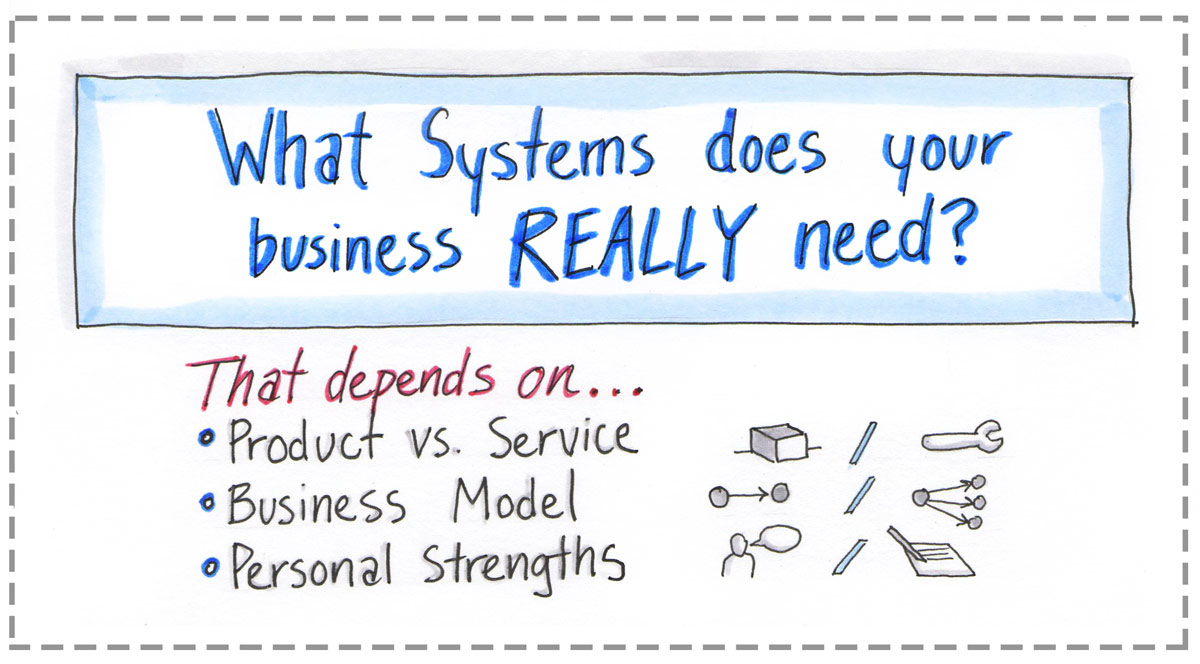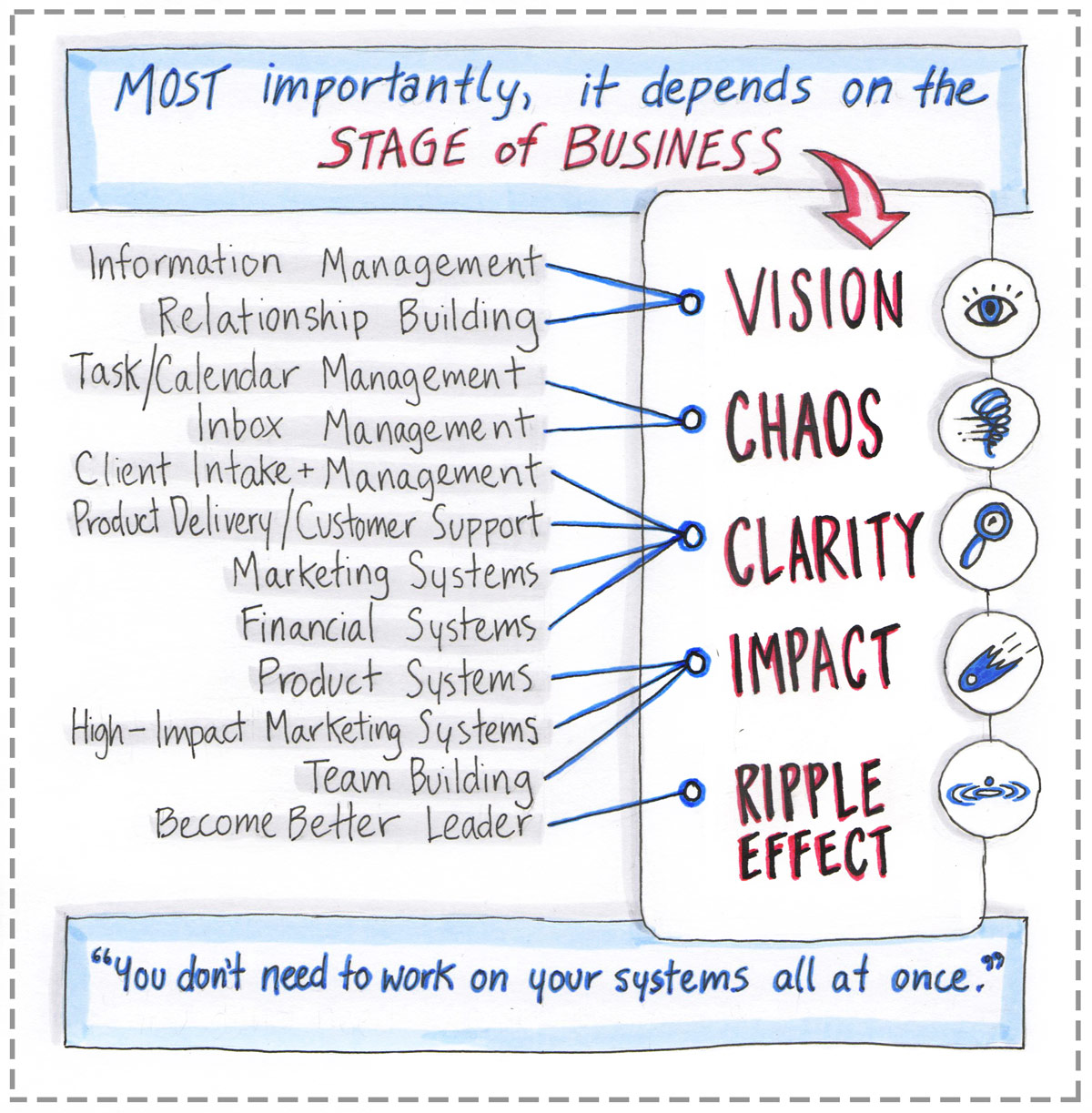 Ever wonder what systems you absolutely must take care of right now and which ones can wait?
Ever wonder what systems you absolutely must take care of right now and which ones can wait?
Not all systems are as essential as others. And, what’s crucial to one business owner might not be vital to another.
The nature of your business is a determining factor in which systems you really need. Those of you who sell products might not need the same systems as those of you who have service-based businesses. Your business model also factors into the equation. One-on-one services don’t always require the same systems as group programs.
Personal strengths and preferences are also important to consider. You might be great on the stage and use public speaking to rally people to your cause or you might use books and blogging as your main marketing tools. These things need to be taken into consideration when it comes to systems.
But what’s the most decisive factor when it comes to prioritizing systems?
The stage your business is in is the most critical factor.
There are many ways to classify the stage of your business, but the one that resonates most with me is the one by Todd Herman. He defines five stages of a growing a business: Dream Up, Start Up, Ramp Up, Scale Up, and Leader Up.
In other words: Vision, Chaos, Clarity, Impact, and Ripple Effect.
As your business goes through each stage, it’s critical that you work on the systems pertaining to that specific phase. “Skipping” a set of systems results in a shaky foundation, and you’ll wind up needing to constantly put out fires.
Vision
In this initial stage, you’re just starting to entertain the idea and direction of your business.
You’re doing a lot of research, collecting and analyzing information, and testing your hypothesis.
Critical systems required at this stage are:
It’s crucial to structure the information you’re collecting and make sense of it. You must set aside time to nurture relationships with those who might propel the growth of your business later on. I’m not suggesting that you approach each relationship as a transaction, but I AM saying that you have full control over who you meet and what relationships you nurture.
Chaos
You’ve committed to a business idea, which is great, but. . .
This is a very stressful stage because you find yourself pulled in different directions. You feel that you’re constantly in survival mode and suffer from overwhelm. You ask yourself if the entrepreneurial path is for you and if you’ll ever become one of the success stories.
You’re doing everything yourself and working around the clock to compensate for not having a clear step-by-step plan for how things are done or not possessing the necessary skills.
You experiment a lot, trying different tactics and techniques. You find yourself buying one online program after another hoping that they’ll help you fill in the knowledge gaps because you can’t afford to hire someone to help you. But, invariably, those programs start collecting dust on your hard drive because of something else, seemingly more important, gets your attention.
Know that this is just a phase that every startup goes through. My journey was no different. My first year in business was torturous for the exact same reasons.
Remember, it’s not because you are not enough. You ARE enough. You just need to get through this stage.
Make this part less painful with systems like:
- Task and calendar management
- Inbox management – Here are the tools that can help you do that.
Concentrate on personal systems that help you approach your workload in a more structured and organized way. Notice that I’m not using the phrase time management, which I find very disempowering, because you don’t really have control over time. But you can definitely manage yourself. And that’s the ultimate goal at this stage.
Clarity
Now you’re experiencing more confidence and certainty. There are still plenty of highs and lows, but you notice a positive progression. You have returning clients and clients that rave about your work. It makes you happy and super proud despite the fact that you majorly over-deliver and underprice your services.
The upside is that now you know who you’re serving and what services or products you want to offer. After test marketing tactics, you know what works best and what you need to do more of in order to bring in more clients and grow your business.
The downside is that you still work long hours. You start experimenting with delegating, but for the most part, you do everything yourself. Now that your business has grown, you have even more balls to juggle. It’s doable, but because your business depends so much on you doing it all, the smallest hiccup—from a client emergency to the flu—can send your fragile structure tumbling down.
Another problem is that your time in its entirety is spent on sustaining your business. There’s no time left to work on projects, new programs, or services to grow your business. You’re at your limit and can’t fathom adding anything else to your plate.
Therefore, it’s critical to structure repetitive activities that you engage in on a regular basis.
These can be:
- Client intake and management (if you are a service-based business, reinventing the wheel with every new client can be a time suck. Structuring your client work will save you massive amounts of time)
- Product delivery and customer support (when not delivered correctly, digital programs can eat up every minute of your time. If that’s you, look into creating a better system)
- Marketing systems (depending on your preference)—referral system, blogging, social media, podcasting, public relations, webinar delivery, guest posting, interviewing, etc.
- Financial systems— a more organized way of managing tasks related to financials like invoicing and bookkeeping.
Being more consistent when doing repetitive activities saves you from having to waste time figuring out how things are done or remembering where you left off when you get interrupted. Another reason for formalizing your processes at this stage is that you can delegate either the entire process or parts of it to ensure that things are done the way you want them to be done.
This can be achieved simply by creating checklists or cheat sheets. For example, here’s my client management checklist. And, here’s my guest blogging checklist.
If you haven’t found an optimal way to manage your tasks and e-mail, it might be good to revisit the systems from the previous stage.
Impact
You’re ramping up your business. You’ve seen quite a bit of success. Your services and products are selling well, and you feel that your prices reflect the value your clients are getting.
You also feel certain in your abilities, the impostor complex rears its ugly head less frequently, and you are practically cured of the shiny object syndrome. People are clamoring for your time and you are bombarded with interviewing opportunities. In many respects, you feel that “you’ve arrived.”
Now it’s time to step up to the next level of financial success and step closer to your ideal lifestyle. But there’s much more at stake now. Though you have a small team, you still can’t resist handling the tasks that shouldn’t be on your plate. You’re a perfectionist and want things to be done in a very specific way. So, you spend a lot of time on quality control or simply jumping in and doing something yourself, which puts you at 100% capacity.
You need to free yourself up for strategic work and look for opportunities to attract new customers while working on ways to serve your existing customers for longer periods of time. Building multiple ways to serve your customers will allow for revenue stacking opportunities and will let you increase your revenue without adding much to your workload.
The systems that are crucial for you at this stage are:
- Product systems—a strategically designed set of products (or services) that feed into one another. The benefit of this approach is that by moving the needle on one area of your business model you create output in another area with no additional effort.
- High-impact marketing systems— public speaking, joint ventures or strategic partnerships, organizing conferences or retreats.
- Team building—creating team alignment and refining reporting, follow-up and quality control processes.
This stage is all about optimizing and freeing you to focus on high-impact areas.
Ripple Effect
The last and the ultimate stage is where you’ve mastered the above systems and created a business that runs like a well-oiled machine. We all see success differently, so I’ll let your imagination fill in the blanks here.
At this stage, you keep perfecting your systems and work on becoming a better manager, better CEO of your company, and better community leader for your clients and followers.
This is not a carefree stage (none of it is 🙂 ), but usually, it’s at this stage that you see the biggest ripple effect of your work and the difference that you make in the world.
Conclusion
I hope you feel liberated that you don’t need to work on all your systems at once.
In fact, it’s better to take the time to develop your systems slowly and methodically. You need time to experiment to determine what naturally makes you effective. What is the combination of offerings that delivers the most value to your customers and what marketing activities work and what don’t?
So, don’t rush. Come back to this chart on a regular basis to evaluate your priorities. When moving from one stage to the next, do an assessment of tools to see if you need something more robust.
If in doubt, e-mail me and let me know what question you need an answer for. I’m here for you when you need me. 🙂
I want your work to have incredible ripple effects!
Back to you
What stage are you at right now? What system is at the top of your priority list?



